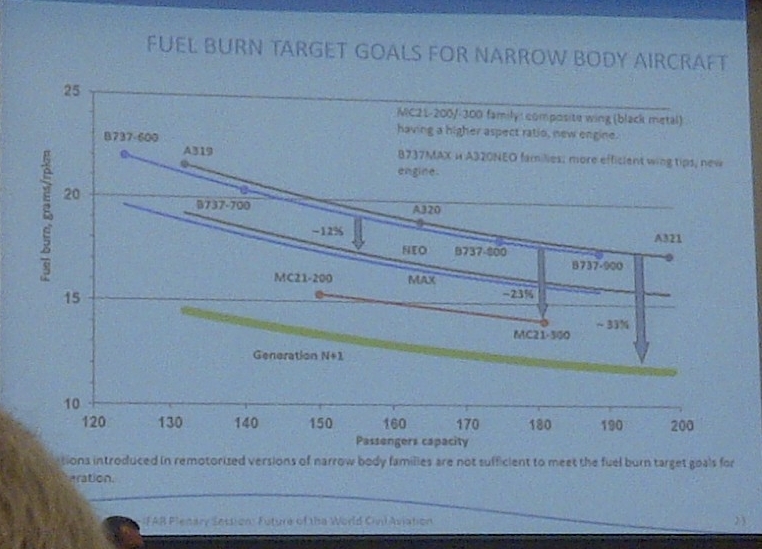Leeham News and Analysis
There's more to real news than a news release.
Irkut makes 10% fuel advantage claim over NEO, MAX for MC-21
Russia’s Irkurt claims its MC-21 mainline jet, a direct competitor to the Airbus A320/321neo and Boeing 737-8/9 MAX, will be some 10% more economical. Irkut claims the MC-21 will be up to 23% more efficient than the current engine-powered Airbus and Boeing products.
Thanks to a reader who is at the MAKS air show, we received this photo from a slide presentation. Although others may have seen this information before, this is the first time we have.
Other MAKS news:
- Sukhoi inked orders for some more Superjet 100s.
- Still no announcements from Airbus, Boeing or Embraer.
- Ilyushin Finance Corp and Bombardier announced that the first Russian operator of the CSeries CS300 will Vim Airlines. IFC ordered 32 with 10 more options at the Paris Air Show.
In other news, Boeing and Canada’s WestJet announced a letter of intent for 65 737 MAXes: 25 MAX 7s and 40 MAX 8s. This will enable WestJet to expand and replace its 737 NG fleet. Delivery begins in September 2017, making WestJet one of the first operators.
Odds and Ends: SuperJet 100; cell phones on airplanes; 787 real-time monitoring; Crikey
SuperJet 100: This airplane, which is basically the old Dornier 728 jet design, was supposed to be Russia’s leap to western standards. It hasn’t worked out that way, according to this article.
Cell Phones on Airplanes: There continues a debate over whether cell phones really have to be turned off for take-off and landing. This finally explains the technical issues of the cell phone and other electronic devices.
787 Real Time Monitoring: NPR (the national public radio in the US) has this report about Boeing’s real-time monitoring of the worldwide 787 operations.
Crikey: The ever-direct (and cranky) Ben Sandilands weighs in on the Airbus-Boeing advertising tiff.
Assessing the Superjet crash
It’s always dangerous jumping to conclusions about an airliner crash within hours or days after an accident, but the speculation began very quickly after the Sukhoi Superjet went missing yesterday in Indonesia.
Despite the demographic of the passengers on board, Russia floated the possibility the aircraft had been hijacked. This seemed an incredible possibility given the passengers were made up of airline executives, journalists and members of the Indonesian aerospace industry.
The facts, though sparse, seemed to parallel other accidents throughout aviation industry over the decades. The captain of the flight asked for clearance to descend to 6,000 ft from 10,000 ft in a mountainous area where peaks were 6,200 to 7,000 ft (reports varied). It wasn’t clear what the weather was at the time the airplane disappeared, but searches were suspended later in part because of fog.
Descending to an altitude below the mountain tops suggests that CFIT (and pilot error) might be involved. CFIT stands for Controlled Flight Into Terrain.
But the altitude of the crash site was reported to be around 5,800 feet, slightly below the clearance. Does this suggest equipment malfunction? Or did the pilot “break” altitude, a not unknown occurrence.
If weather was a factor, might there have been wind shears at play?
What does this accident do to Sukhoi’s reputation? This column concludes it is destroyed. We aren’t ready to agree with that.(Update, 9:30am PDT: The headline on the column has been changed to suggest there is now an “operational risk” to the program as opposed to the program being “destroyed.”) (Update, 3:30pm PDT: Now the headline is about “reputational risk….”)
If this turns out to be pilot error or a weather-driven accident, why should the plane’s reputation suffer? If it is an equipment failure, a lot of Western equipment is on the aircraft and perhaps the fault might lie there.
What do readers think?


